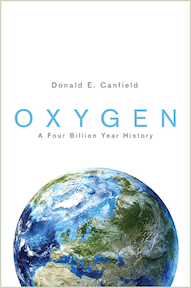By David L. Kirchman
For its first 1.5 billion years or so on earth, life did just fine without any oxygen in the atmosphere. Then about 2.3 billion years ago oxygen concentrations started to rise, and the planet was never the same again. Don Canfield, an earth scientist at the University of Southern Denmark, tells us how these changes in oxygen came about and how we know all this. He guides the reader through a thicket of arcane isotopes, exotic elements, and ancient rocks, while on the way pointing out gaps in the geological record and recounting debates among his colleagues. Canfield shows us how his science is done, and weaves together molecular biology, geology, geochemistry to tell this history of the air we breathe.
Analogs of early, oxygen-free life can be found at Yellowstone National Park, visited by Canfield when he was a kid growing up in Ohio. In addition to geysers and bears, the park has hot springs colonized by vibrantly colored mats of anoxygenic photosynthetic microbes, bacteria that do not produce oxygen while carrying out primary production. Ancestors of these microbes were the basis of early life on earth. Canfield discusses the biochemistry of photosynthesis (he is equally at home in molecular biology and paleoceanography) and mentions the genetic evidence indicating that anoxygenic photosynthesis evolved before oxygenic photosynthesis, the process in modern plants and algae that produces oxygen. That picture is consistent with the geological record. The oldest rocks surviving from the Archean Eon lack oxidized iron, aka rust, which forms when iron and oxygen meet.
Oxygen’s appearance in the atmosphere was so momentous that Canfield and colleagues call it the “Great Oxidation Event,” or GOE. Canfield patiently explains the sulfur isotope evidence (mass independent fractionation, if you must know) that pinpoints GOE’s date of 2.3 billion years ago fairly precisely. Why that date and not earlier is more puzzling. Oxygenic photosynthesis seems to have been invented by cyanobacteria as early as 2.7 billion years ago. Oxygenic photosynthesis is vastly superior to anoxygenic photosynthesis, yet the geological evidence suggests only “whiffs” of oxygen before the GOE. Canfield presents his argument that hydrogen and other oxygen-consuming gases from tectonic activity overwhelmed the oxygen produced by early cyanobacteria. As the earth aged and cooled, tectonic activity and the release of oxygen-consuming gases decreased, allowing oxygen to accumulate in the atmosphere.
While the GOE was indeed great, marking a turning point in earth’s history, oxygen concentrations were still very low at the time, much less than 1% of modern levels. It took another 500 million years, maybe more, before oxygen reached its current level in the atmosphere. And it was not a steady, smooth increase. Canfield discusses the evidence for an iron-filled deep ocean, called the Canfield Ocean by other paleoceanographers, as evidence of low atmospheric oxygen several millennia after the GOE. He then takes us to a small pub in Trepassey, Newfoundland, for warm soup and whiskey after a long field trip. There we learn what molybdenum concentrations and isotopes tell us about the rise of oxygen concentrations during the Neoproterozoic Era 542 million years ago. That chapter ends with a discussion of whether high oxygen concentrations made animal evolution possible or whether it was the other way around.
So many eons and grand theories about earth history packed into such a small book. The science can be tough to follow at times, but Canfield uses inventive analogies to explain complex concepts and biographic tidbits of historical figures and colorful colleagues to bring life to dry numbers and old rocks. There are autobiographical asides here too, self-effacing notes about being rejected by graduate schools and not getting a coveted faculty position. The end result is a fascinating story of this most important gas.
David L. Kirchman (ΦBK, Lawrence University, 1976) is the Maxwell P. and Mildred H. Harrington Professor Marine Biosciences at the University of Delaware and a resident member of the Alpha of Delaware Chapter of Phi Beta Kappa.




